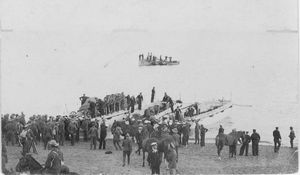Catalogue number 141045
Royal Navy landing Australian Light Horse
This is a most interesting photograph of troops and horses landing on a beach with the Royal Navy but it raises more questions than answers. We can see: far background are transport ships, one (center) with a white diamond on the funnel. Right of this transport is the faint outline of a four-funnel cruiser (see following photograph). Center of the photograph is a two-funnel pinnace or picket boat with the letter B on the bow. Alongside are two small barges and a rowing boat. In the foreground are three landing barges or horse boats with the bow door down, one has disenbarked its charge of horses whilst others are moving off the second barge which also appears to have sacks of forage abord. On the third barge, men are unloading what appears to be a wheeled water bowser. On the beach, we can see Australian soldiers wearing the slouch hat and with their horses, some mounted (far left corner), other soldiers are wearing peaked caps (men of the 10th and 11th battalion and 1st Field Company, Australian Engineers wore peaked caps, for example). There are also Royal Navy sailors and several Midshipmen*. Note the very young Australian Light Horse man about one quarter in from the left of the photograph. Nobody seems to be in a hurry so it is difficult to imagine that the photograph was taken during action in the Gallipoli landing although everything points to that. * Royal Navy midshipmen, in charge of the picket boats although only in their late teens, performed many heroic acts during the Anzac Cove landing and earned great respect from the ANZAC forces. Center foreground is a midshipman talking with an ANZAC officer.
Quote from "Steam Pinnace 199 - Newsletter - September 2024", "Of the Navy's share of V.C.'s during the war, one fell to a young midshipman, Mr. W. St. A. Malleson, of H.M.S, Cornwallis. The occasion was that of the famous River Clyde landing at "V" beach during the operations in Gallipoli. ..... In this he was assisted by an R.N.R. midshipman, Mr. Drewry, and Mr. Malleson, Midshipmen R.N. .... All three officers were most deservedly awarded the coveted bronze cross, "For Valour". In addition to this, nineteen Distinguished Service Crosses were won by midshipmen of the Royal Navy during the war. These were mostly for services in picket-boats under fire off the beaches of Gallipoli. ....There was, indeed, some splendid work performed by these young gentlemen, many of them only fifteen years of age, round those shell-torn beaches. A whole book might well be devoted to this subject alone. But perhaps the finest testimony was that of the Australian troops. Brave though they were, they were not exactly renowned either for discipline or respect for authority. But, although the red tabs of a general might, and frequently were, passed by without notice, the midshipman's white patch invariably brought forth from these hardy warriors a smart salute."
14cm x 9cm Gelatin silver print
|
 |